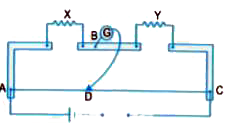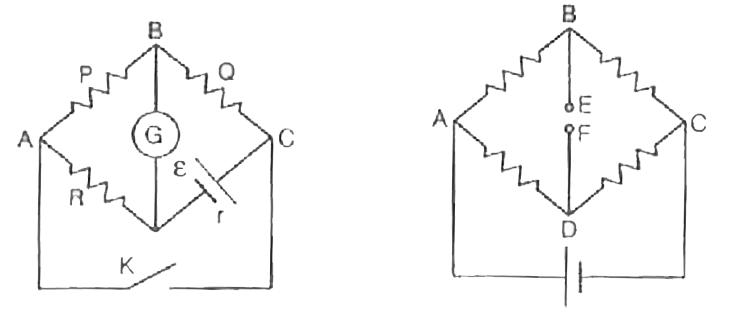In a wheatstone bridge if the battery and galvanometer are interchanged then the deflection in galvanometer will
change in previous direction
not change
change in opposite direction
none of these.
The correct Answer is:B
To solve the question regarding the deflection in the galvanometer when the battery and galvanometer are interchanged in a Wheatstone bridge, we can follow these steps:
1. Understand the Wheatstone Bridge Configuration:
A Wheatstone bridge consists of four resistances (let's denote them as P, Q, R, and S) arranged in a diamond shape. A galvanometer is connected between the junction of P and Q and the junction of R and S. A battery is connected across the bridge.
2. Initial Condition:
In the balanced condition of the Wheatstone bridge, the ratio of the resistances is given by:
PQ=RS
This can also be expressed as:
PS=QR
In this state, the galvanometer shows no deflection.
3. Interchanging Battery and Galvanometer:
When we interchange the positions of the battery and the galvanometer, the galvanometer is now connected where the battery was, and the battery is connected where the galvanometer was.
4. New Configuration:
The new configuration will still have the same resistances P, Q, R, and S. The galvanometer is now in series with one of the resistances, and the battery is in the position where the galvanometer was.
5. Analyzing the New Condition:
The new circuit can be analyzed similarly. The balancing condition remains the same because the ratios of the resistances have not changed. Therefore, we still have:
RP=SQ
This means that the condition for balance is still satisfied.
6. Conclusion on Deflection:
Since the balancing condition remains unchanged, the deflection in the galvanometer will also remain unchanged. Thus, the deflection in the galvanometer will be zero, just as it was in the initial condition.
Final Answer:
The deflection in the galvanometer will not change when the battery and galvanometer are interchanged.
---
A Wheatstone bridge consists of four resistances (let's denote them as P, Q, R, and S) arranged in a diamond shape. A galvanometer is connected between the junction of P and Q and the junction of R and S. A battery is connected across the bridge.
In the balanced condition of the Wheatstone bridge, the ratio of the resistances is given by:
PQ=RS
This can also be expressed as:
PS=QR
In this state, the galvanometer shows no deflection.
When we interchange the positions of the battery and the galvanometer, the galvanometer is now connected where the battery was, and the battery is connected where the galvanometer was.
The new configuration will still have the same resistances P, Q, R, and S. The galvanometer is now in series with one of the resistances, and the battery is in the position where the galvanometer was.
The new circuit can be analyzed similarly. The balancing condition remains the same because the ratios of the resistances have not changed. Therefore, we still have:
RP=SQ
This means that the condition for balance is still satisfied.
Since the balancing condition remains unchanged, the deflection in the galvanometer will also remain unchanged. Thus, the deflection in the galvanometer will be zero, just as it was in the initial condition.
The deflection in the galvanometer will not change when the battery and galvanometer are interchanged.
Topper's Solved these Questions
- CURRENT ELECTRICITYBOOK - NCERT FINGERTIPSCHAPTER - CURRENT ELECTRICITYEXERCISE - Meter Bridge
4 Videos
- CURRENT ELECTRICITYBOOK - NCERT FINGERTIPSCHAPTER - CURRENT ELECTRICITYEXERCISE - Potentiometer
7 Videos
- CURRENT ELECTRICITYBOOK - NCERT FINGERTIPSCHAPTER - CURRENT ELECTRICITYEXERCISE - Kirchoff'S Law
11 Videos
- COMMUNITCATION SYSTEMSBOOK - NCERT FINGERTIPSCHAPTER - COMMUNITCATION SYSTEMSEXERCISE - HOTS
10 Videos
- DUAL NATURE OF RADIATION AND MATTER BOOK - NCERT FINGERTIPSCHAPTER - DUAL NATURE OF RADIATION AND MATTER EXERCISE - Assertion And Reason
15 Videos
Similar Questions
Knowledge Check
If in the experiment of Wheatstone's bridge, the positions of cells and galvanometer are interchanged, then balance point will
AChangeBRemain unchanedCDepend on the internal resistance of cell and resistance of galvanometerDNone of theseThe deflection in moving coil galvanometer is
Adirectly proportional to the torsional constantBinversely proportional to the area of the coilCinversely proportional to the currentDdirectly proportional to the number of turns in the coilThe deflection in a moving coil galvanometer is
ADirectly proportional to the torsional constantBDirectily proportional to the number of torsional coilCInversty proportional to the area of coilDInversely proportional to the current flowing
(i) In a meter bridge , the balance point is found to be at 30cm from the end A when resistance R in left gap of bridge is of 12Ω. Find resistance S in the right gap of bridge
(ii) If the cell and the galvanometer are interchanged in the balance point, would it effect flow of current through the galvanometer
(iii) Calculate the balance point of the bridge if R and S are interchanged
View SolutionA meterbridge is in balance condition. Now if galvanometer and cell are interchanged, the galvanometer shows no deflection. Give reason.
View Solution(a) In a metre bridge the balance point is found to be at 39.5 cm from the end A, when the resistor Y is of 12.5 Ω . Determine the resistance of X. Why are the connections between resistors in a Wheatstone or metre bridge made of thick copper strips ?
(b) Determine the balance point of the bridge above if X and Y are interchanged.
(c ) What happens if the galvanometer and cell are interchanged at the balance point of the bridge? Would the galvanometer show any current ?

View SolutionIn the modified whetstone bridge (fig), find the concition for no charge in deflection of the galvanometer on opening or closing the key K.

View Solution
A two terminal when connected in series with a battery and a galvanometer in series with it through a two way key as shown in figure. The galvanometer shows maximum deflection which gradually decreases to zero, when key k1 is close and k2 open. Now key k1 is open and k2 is closed. Now battery is disconnected and galvanometer is directly connected to the same device the deflection in galvanometer is maximum and reversed and decreases to zero gradually. The device is-
View Solution